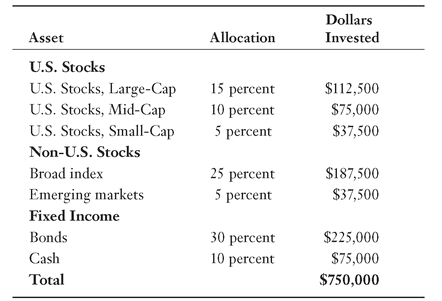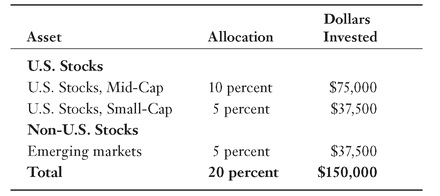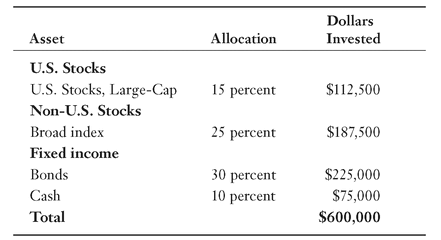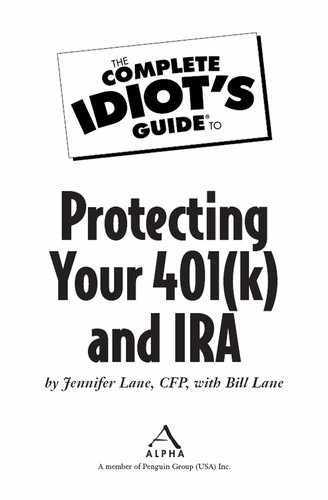Asset Allocation for a Long Retirement
Unless you have a very large nest egg, if you’re retiring young, you’ll probably have more money in stocks than an older retiree with a shorter retirement time frame might have. Time horizon, and therefore the expected return on different types of investments over time, is more important than minimizing risk when you calculate your asset allocation. If you’re retiring early, you have a longer time horizon, so you need more exposure to stocks in your accounts, and that means accepting a bit more risk to achieve longer-term growth.
Retiring at a younger age, though, doesn’t mean that you’re immune to the psychological effects of leaving your employment and the steady paycheck behind and moving into retirement. Retirees are often surprised to find that market fluctuations they once took in stride as workers seem more alarming to them now that they’re relying on their nest eggs to provide income or to continue to grow without regular infusions of more savings. A review of the reasons that your asset allocation makes sense and a few tricks to level the inevitable ups and downs will help make early retirement money management less stressful.
Realize that your risk tolerance can change based on how you feel about the economy and that your partner’s tolerance for risk could be much different than yours. As you’re getting ready to retire early, pay extra attention to risk tolerance at your monthly money meetings. Each of you should complete a risk-tolerance questionnaire every three or four meetings.
You don’t always have to use the same website risk-tolerance calculator. Mix it up. One quarter, pick the one from www.CalcXML.com; another time try the one on your broker’s website or the one at www.AARP.org. Regular risk-tolerance checks will keep the noninvesting partner involved and give him a chance to discuss his feelings about your shared portfolio. This is often overlooked if one of you is assigned the job of managing the investments or meeting with the investment advisor. This extra step will also head off problems if the portfolio value changes more rapidly than the less-involved partner is expecting and will help him feel more comfortable with how the accounts are being managed.
Measuring your risk tolerance once a quarter will help you gauge how the economy might be affecting what you feel about investment risk. This exercise is meant to educate you about how your tolerance ebbs and flows with the economy and to keep you communicating about how you feel about risk. It isn’t meant to make you change your asset allocation each quarter, especially since your age is a significant component in determining your asset allocation.
Changing the Mix
Factoring in your risk tolerance when you decide on an asset allocation is important. If the portfolio is too volatile, you’ll have trouble sticking with the asset mix and might be tempted to sell investments when their value is down, which can do a lot of damage to your nest egg. In contrast, if the portfolio is too conservative and doesn’t take enough risk, it may not keep up with inflation. The longer you need your nest egg to grow, the greater the risk of inflation cracking it. If you’re planning to retire early, this means your asset allocation may have to be more risky and more volatile than you’re immediately comfortable with.
Your age needs to be a bigger factor in creating your asset allocation than your risk tolerance, especially if you are retiring early and will need the nest egg to provide you income that keeps pace with inflation over your lifetime.
Let’s try an experiment to see how this works. Pull out your favorite online asset allocator calculator. The one at www.Dinkytown.com in the “Investment Calculators” section works well for this comparison, so we’re using the factors they look for in the following chart. Run two hypothetical scenarios: one for you, the early retiree, and one for your friend who is your age but plans to work to age 66. The assumption is that you and your friend both expect to live for a long time in retirement. The only difference between the two of you is that you’re starting your retirement earlier than she is.
Input these assumptions so you can make an easy comparison:
Calculation 1: Your Early Retirement Plan
Age: 55
Current assets: $500,000
Savings per year: $0
Marginal tax rate: 25 percent
Nest egg income required: 3 percent
Risk tolerance: moderate
Economic outlook: moderate
Calculation 2: Your Friend’s Regular Retirement Plan
Age: 55
Current assets: $250,000
Savings per year: $10,000
Marginal tax rate: 25 percent
Nest egg income required: 0 percent
Risk tolerance: moderate
Economic outlook: moderate
Notice that the only differences between the two calculations are the things that you would expect to be different between an early retiree and someone who is still in savings mode. The early retiree has a larger nest egg, isn’t saving anymore, and needs income from her portfolio. The friend who’s still working has a smaller portfolio, is still saving, and doesn’t need income from the investments.
The result of this experiment shows you how important age is. According to the results of the www.Dinkytown.com asset allocator calculation, the assigned stock allocation for both you and your friend is within 5 percent of each other. She is still saving, and you’re not, but because of your ages, your asset allocation is very similar. Retiring early means you’ll have a more volatile portfolio, with more risky stock investments, than you would if you waited to retire when you are older.
Leveling the Bumps
One helpful way to smooth the upward and downward swings in your investment account balance as the economy vacillates is to segregate the more volatile stocks into an account that you can clearly, and psychologically, see as your long-term money. As short-term swings hit the account, you can take comfort knowing that its longer time horizon helps ensure that the underlying value trend is steadily upward. And, of course, that means you’ll be keeping your less-volatile fixed-income securities, bonds, and cash in an account of their own. The steadiness of the fixed-income account will reassure you that you have cash and income available for current income needs even when the stock market is softening.
Let’s look at a chart to see how this would work:
If you had a $750,000 portfolio with a target asset allocation of 60 percent stocks and 40 percent bonds, your goal for the whole portfolio might look like the following.
Goal for the Whole Portfolio

The most volatile asset classes would be small- and mid-cap U.S. stocks and emerging market stocks. These would account for 20 percent of the whole portfolio, or $150,000.
Volatile Asset Classes

The less-volatile asset classes would be the large-cap U.S. stocks, the broad index non-U.S. stocks, and of course, the bonds and cash. These would account for 80 percent of the portfolio, or $600,000.
Less-Volatile Asset Classes

The assets in the volatile asset class are meant to help your account grow with inflation. The money in this account has a much longer time frame than the accounts you’ll start drawing on for retirement. By segregating the $150,000 in volatile assets into a taxable account, it will be easier to keep in mind that account balance fluctuations are an expected part of long-term investing.

Nest Eggs
Use a taxable account for as much of the more volatile assets as you can so you can take advantage of lower capital gains taxes on profits and be able to “harvest gains and/or losses” at year-end by selling investments that have lost money against investments with gains.
..................Content has been hidden....................
You can't read the all page of ebook, please click here login for view all page.
